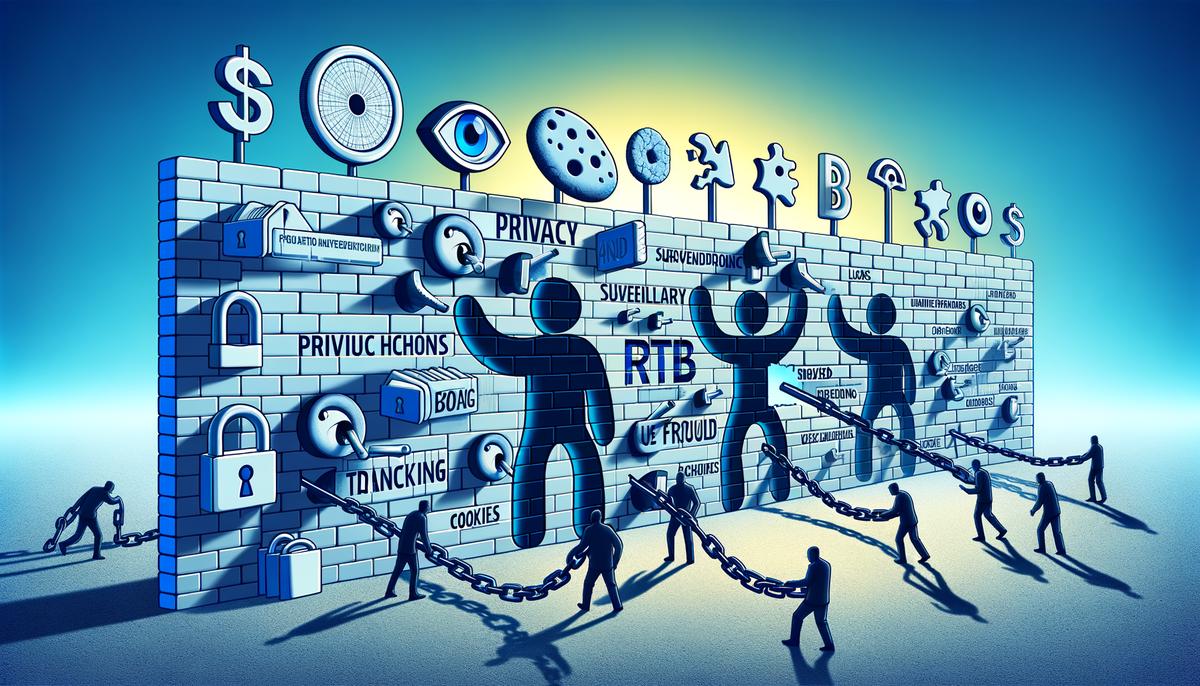Real-time bidding (RTB) has quietly revolutionized the way digital ads find their way to our screens, turning what was once a straightforward process into a dynamic auction system that operates at the speed of light. Imagine a world where every online ad space is a battleground, with algorithms and data analytics as the weapons of choice. This is the landscape of RTB, a system that matches ads with viewers in milliseconds, ensuring that the digital space is as efficient as it is fast-paced.
Understanding Real-Time Bidding (RTB)
Real-time bidding (RTB)
takes the digital advertising world by storm, enabling ads to connect with people instantly and efficiently. Picture this: every time you load a webpage, an automated auction happens lightning-fast, determining which ad you’ll see. That’s RTB in action. Unlike traditional ads, where space is bought and sold in advance, RTB matches ads to viewers in the blink of an eye.
At its core, RTB operates within an advertising marketplace. Advertisers and publishers throw their hats into the ring, using sophisticated algorithms to bid on ad spaces based on a plethora of factors, such as viewer demographics and browsing history. Think of it as eBay, but for ad spaces, and transactions happen quicker than you can click refresh.
Here’s the kicker: every single ad slot on a web page could come from a different advertiser. That’s because RTB auctions operate for each ad space individually, allowing advertisers to target users more precisely than ever before. This level of targeting is like aiming a digital arrow in a vast online universe, ensuring it lands exactly where it’s most effective.
The shift towards RTB has majorly disrupted the traditional advertising process. Before, buying ad space was akin to securing a billboard on a busy highway, essentially a guesswork game about who might see it. With RTB, it’s more like sending a personalized invitation to users who are most likely to be interested in the ad.
Crucially, RTB isn’t just about being fast; it’s also about being smart. Advertisers set the rules — defining when, where, and what kind of ads to show — and RTB technology does the heavy lifting. Plus, they only pay what they bid for, often leading to more cost-effective ad spending. It’s a win-win: ads reach interested folks, and budgets stretch further.
Moreover, the real-time nature of these bids doesn’t just mean speed; it brings unparalleled agility to digital campaigns. Advertisers can adjust their strategies on the fly, tweaking bids based on immediate feedback and performance metrics. This real-time data loop ensures that campaigns are not just reactive but proactive.
To sweeten the pot, ad exchanges and Demand Side Platforms (DSPs) come into play, smoothing out the RTB process. These platforms act as digital matchmakers, helping advertisers find their ideal audience spaces without breaking a sweat. Through a blend of technology and strategy, DSPs amplify RTB’s power, making ad campaigns smarter and more streamlined.
What makes RTB truly revolutionary is its impact on the advertising and publishing ecosystem. For advertisers, it opens up a world of possibilities for precise targeting and real-time adjustments. For publishers, it maximizes the value of their ad space by ensuring that each slot is filled with the most relevant, highest-paying ad available.
In essence, real-time bidding has redefined the digital ad landscape. It’s turned advertising into a dynamic, instantaneously responsive mechanism that benefits advertisers and viewers alike. As algorithms get smarter and data analytics more refined, the future of RTB shines brightly—a beacon in the evolution of online advertising where efficiency, effectiveness, and engagement reign supreme.

The RTB Process
When a user lands on a webpage, the RTB process kicks into high gear. Here’s how the magic unfolds, step by step.
First up, the website sends an ad request. This isn’t just any shout into the digital void; it includes details about the webpage content, the user’s demographic info, and their online behavior patterns. Think of it as the website’s way of saying, “Hey, here’s someone who might be interested in what you’re selling.”
Enter the Supply Side Platform (SSP). It’s the bridge between the website and the ad exchange. The SSP takes this ad request and shoots it over to the ad exchange, a bustling digital marketplace where ads find their homes.
The ad exchange then broadcasts this opportunity to a slew of interested parties through what’s essentially an auction on steroids. With the precision of a finely-tuned orchestra, Demand Side Platforms (DSPs) analyze the ad request’s details in milliseconds. Advertisers leverage DSPs to weigh the value of the ad impression based on the provided user data.
Here’s where the bidding war begins. Advertisers place their bids through DSPs, specifying how much they’re willing to pay to display their ad to this particular user at this particular moment. It’s like eBay, but faster and for ads, with each participant trying to outdo the others while sticking to their budget.
But how is the winner chosen? It’s not merely about who offers the most money. The ad exchange evaluates each bid, considering factors like the ad’s relevance and the likelihood of user engagement, much like a high-speed dating matchmaker trying to find the perfect pair.
Once a winner is decided, their ad gets the green light to appear on the website. This happens so swiftly that the user doesn’t even notice the behind-the-scenes hustle. They simply see a relevant ad pop up, ideally matching their interests or solving a problem they didn’t even know they had.
Throughout this process, algorithms and technologies ensure that decisions aren’t just fast, but smart. They analyze vast amounts of data in real-time, learning and adapting with each ad request to maximize effectiveness and efficiency.
The key takeaway here is the blend of speed, precision, and intelligence that defines the RTB process. From the moment a user visits a website to the instant an advertisement graces their screen, every step is orchestrated to ensure that ads meet viewers in the most contextually relevant and timely manner possible. This isn’t just the future of online advertising; it’s a seamless, ongoing reality that continues to evolve and redefine user experiences daily.

Key Players in RTB
Data Management Platforms (DMPs) stand as the backbone of knowledge for the RTB scenario, streamlining data from various sources to create a comprehensive view of target audiences. They act as warehouses storing immense volumes of data ranging from demographic details to browsing habits collected by cookies. This insight into user preferences allows for more focused and effective advertising strategies, as DMPs sort and analyze data to identify patterns useful for tailoring ads to the right audience at the right time.
Advertisers align themselves with DSPs not only for their bid in real-time capabilities but also for their seamless integration with DMPs. This relationship enables advertisers to leverage vast datasets for pinpointing potential customers, enriching the bid with deeper insights into consumer behavior. Consequently, the refined targeting potential escalates the chance of winning bids for ad spaces that harbor high conversion prospects.
On the flip side of this coin, publishers employ SSPs to maximize their earnings, but these platforms do much more than just fetching the highest bids. By interfacing with DMPs, SSPs enhance the value of ad inventory, showcasing its potential to reach desired audiences effectively. Publishers can thus present their digital real estate as a prime destination for advertisers aiming at specific market segments, lifting both the demand and price for their ad spaces.
At the heart of the RTB machinery lies the Ad Exchange – a digital marketplace ringing the bell for each transaction between sellers (publishers) and buyers (advertisers) of ad inventory. Think of it as the stock exchange, but for ads. It’s here that DSPs place bids based on intelligence drawn from DMPs, while SSPs list available inventories, equipped with data-powered valuations. The real-time process hinges on algorithmic prowess, ensuring that, within milliseconds, ads from the winning bid are neatly packed off to grace the publisher’s site.
The interplay among these RTB juggernauts engenders an advertising ecosystem bristling with precision and efficiency. Their collaborative effort pushes boundaries, devising new strategies for mapping out undecided internet pathways – all geared towards placing the most relevant ad in front of the most receptive eyes.
By taking on humongous loads of data and weaving them into actionable strategies, DMPs not only sharpen the arrows in advertisers’ quivers but also guide SSPs to recognize the true worth of their inventory. SSP resilience rides on showcasing compelling reasons for advertisers to direct their bids towards their available spaces, while DSPs thrive on slicing through data clutter to clinch the best spots for their ads at the most rational price point.
In essence, each RTB player relies on a dance between data and technology. Whether it be poring over behavioral data to whip up compelling ad strategies or leveraging algorithmic sophistication to ensure a fair yet favorable bid outcome, their roles pivot on exploiting this synergy. The result? An RTB ecosystem that breathes life into ads, ensuring they find a place not just anywhere but where they’ll make the strongest impact.

Benefits and Challenges of RTB
RTB brings a dynamic twist to online advertising with increased efficiency and fine-grained targeting, enabling advertisers to launch personalized campaigns at scale. However, challenges such as privacy concerns and ad fraud cast shadows over its bright prospects.
Ad fraud remains a stubborn thorn in RTB’s side, with bots and fraudulent websites tricking systems into paying for nonexistent, or non-human, ad views. Advertisers pour considerable resources into fighting this issue, employing advanced technologies and oversight to mitigate fraud’s impact, yet it persists as a drain on industry resources and budgets.
Concerns over user privacy have become increasingly pronounced. RTB operates by leveraging detailed user data to serve targeted ads. As such, it potentially exposes sensitive information, triggering fears of surveillance and data breaches among consumers. Regulations like GDPR in Europe and CCPA in California have emerged as responses, compelling advertisers and publishers to navigate a complex legal landscape to ensure compliance while still targeting effectively.
Furthermore, the RTB market’s complexity can overwhelm newcomers. With multiple moving parts including DSPs, SSPs, ad exchanges, and DMPs, each serving distinct yet interdependent roles, the learning curve for effectively leveraging RTB is steep. This complexity also extends to the creation and optimization of campaigns, requiring deep insights into both technology and current market trends for success.
From a different angle, the pressure on publishers can be intense. To maximize their earnings through RTB, publishers must strategically manage their digital real estate, balancing content quality and user experience against the temptation to fill every possible nook and cranny with ads. Overloading pages with ads can lead to negative user experiences, driving valuable audience members away.
Yet, amidst the challenges, the potential for advertisers to achieve higher revenues and for publishers to monetize content more effectively cannot be ignored. This delicate balance highlights the need for ongoing innovation, regulation, and education to address RTB’s drawbacks while harnessing its considerable capabilities for transforming online advertising. Continuing evolution in technology and strategy promises to refine RTB processes further, aiming for a future where benefits like efficiency and precision targeting outweigh concerns such as privacy breaches and fraud.

Future Trends in RTB
In the realm of real-time bidding (RTB), Artificial Intelligence (AI) and machine learning algorithms are increasingly playing a pivotal role. These technologies enable more accurate predictions about which ads a user is likely to interact with, based on their browsing behavior and historical data. AI’s ability to process and analyze vast datasets in real-time enhances the decision-making process in the auction, leading to more personalized and efficient ad placements.
Blockchain technology is emerging as a solution to several pervasive issues within the RTB ecosystem, including transparency and fraud. By incorporating blockchain, each transaction within the RTB process can be recorded on a decentralized ledger, providing a clear, immutable record of ad placements, bids, and transactions. This could significantly reduce the occurrence of ad fraud and increase trust among advertisers, publishers, and users.
Interactive and immersive ad formats powered by augmented reality (AR) and virtual reality (VR) are set to revolutionize the user experience within RTB platforms. These formats offer a novel way of engaging consumers, providing advertisers with creative tools to capture attention in a highly competitive digital environment. As 5G technology becomes more widespread, the increased bandwidth will allow for these complex, immersive ads to be delivered with minimal latency, making them more feasible for widespread use.
Voice search technology is changing the landscape of online advertising, including RTB. As more consumers use voice-activated assistants for internet searches, advertisers are exploring ways to integrate voice search data into RTB platforms. This trend could lead to voice-activated ads or sponsorships within search results, introducing a new dimension to targeted advertising.
Consumer privacy and data protection remain front and center in the evolution of RTB. As regulatory frameworks around data privacy tighten globally, RTB platforms must navigate the dual challenges of providing personalized ad experiences while respecting user privacy. Emerging approaches to this issue include the development of “privacy-by-design” bidding algorithms that optimize ad targeting and placement without compromising sensitive user information.
The rise of Connected TV (CTV) and Over-The-Top (OTT) platforms is opening new avenues for advertisers through RTB. With more viewers shifting from traditional television to digital streaming services, CTV and OTT offer highly targeted advertising opportunities that weren’t possible with conventional TV advertising. RTB platforms are quickly adapting to include these new formats in their auction processes, catering to the demand for more precise targeting in video content.
Cross-device tracking and attribution are becoming increasingly sophisticated within RTB systems. Advertisers are keen on understanding how consumers interact with their ads across multiple devices before making a purchase decision. Advances in cross-device identification are enabling advertisers to track user behavior seamlessly across smartphones, tablets, laptops, and more, leading to more coherent and effective advertising strategies.
Finally, the shift towards server-side header bidding signifies a move towards greater efficiency and fairness in the RTB auction process. Unlike traditional client-side header bidding, server-side bidding reduces latency and improves the user experience by handling bid requests in a server-to-server environment. This approach not only speeds up the ad loading process but also democratizes the auction by allowing a larger number of DSPs to participate, potentially leading to better outcomes for both publishers and advertisers.
These emerging trends indicate that the future of RTB will be characterized by greater technological sophistication, emphasis on user privacy, and the exploration of new advertising formats and platforms. As the landscape evolves, stakeholders across the digital advertising spectrum will need to adapt to these shifts to capitalize on the opportunities they present.

In conclusion, real-time bidding stands as a testament to the power of technology in transforming the advertising landscape. By marrying speed with precision, RTB not only optimizes ad spending but also ensures that advertisements are seen by the most receptive audiences. As we look towards the future, it’s clear that the evolution of RTB will continue to shape the way we experience digital content, making every ad placement not just a transaction, but a carefully calculated decision designed to maximize impact and engagement.




